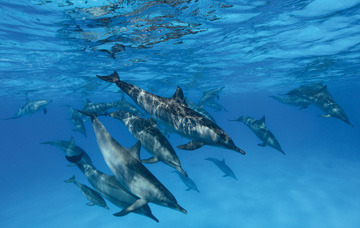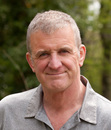Mark Caney's Blog, page 36
May 28, 2013
Dolphin Assisted Birth: Therapeutic or Wishful Thinking?
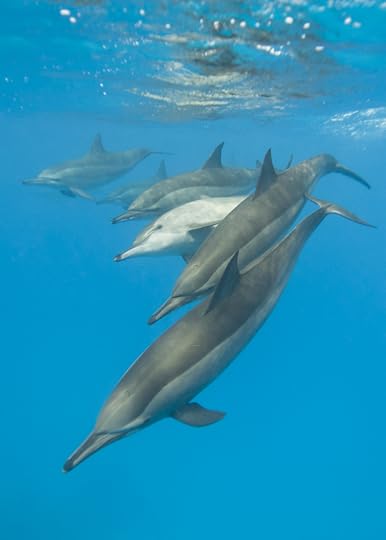 Last month, expectant parents Adam and Heather Barrington, traveled from South Carolina to Pohoa, Hawaii in the hopes of fulfilling their dream of a dolphin-assisted birth. Hosted by The Sirius Institute, the couple expect to form a connection with a dolphin pod during prenatal and postnatal swims. The couple plans for a water delivery among the dolphins, though they have also made contingency arrangements. In the event a dolphin-assisted birth cannot happen, Heather, accompanied by a midwife, will be removed to a nearby family/community farm. It is unclear what would constitute a reason to change the original plan.
Last month, expectant parents Adam and Heather Barrington, traveled from South Carolina to Pohoa, Hawaii in the hopes of fulfilling their dream of a dolphin-assisted birth. Hosted by The Sirius Institute, the couple expect to form a connection with a dolphin pod during prenatal and postnatal swims. The couple plans for a water delivery among the dolphins, though they have also made contingency arrangements. In the event a dolphin-assisted birth cannot happen, Heather, accompanied by a midwife, will be removed to a nearby family/community farm. It is unclear what would constitute a reason to change the original plan.
“We are now receiving up to 3-4 requests per week through the Internet from people searching for a place to birth with dolphins,” claims The Sirius Institute, which describes itself as “a research consortium with the purpose of ‘dolphinizing’ the planet.”
According to founding partner, Paradise Newland, and research director, Michael T. Hyson, Ph.D., “birthing with the dolphins has been an ancient native practice in Hawaii and in other cultures.” Because of a perceived demand, the Sirius Institute has developed the Dolphin Attended, Water, Natural (DAWN) and Gentle Birth Centers in Hawaii. Boasting a mild climate, year-round availability of free dolphins, and supportive cultural milieu, Hawaii is the natural location for DAWN, the partners claim.
It is open to debate whether dolphin-assisted birth is an ancient practice or not, but dolphin-assisted therapy (DAT), as unlikely as that might seem to some, has been around for over 25 years now.
Dr Dolphin
Generally, DAT involves a patient swimming and playing with dolphins in captivity over several sessions while working on tasks that might include hand-eye coordination or response targets. Due to the dolphins being charismatic, exotic animals, it is an attractive form of therapy for individuals who have mental and physical disabilities, in particular autistic children.
Most scientists immediately invalidate DAT as a therapy, not only because of a lack of empirical support but also because of the fact that most people do not encounter dolphins in their daily lives. To attribute therapeutic change solely to DAT, variables such as swimming in the water, being somewhere warmer, traveling and living some place new while receiving therapy need to be controlled for so that these factors do not confound the results of the research.
Similarly, to make any claim that a dolphin-assisted birth is beneficial to mother and child, a researcher would need to unravel the many factors involved in order to tease out the potential effects of the presence of dolphins. From a scientist’s point of view, the potential impact of each element of water birth would need to be looked into as would the potential comfort an animal might bring.
Read full story: Medical Daily

May 21, 2013
Navy Dolphin Finds Rare 130-Year-Old Torpedo
A Navy dolphin training to look for mines off the coast of San Diego found a museum-worthy 19th-century torpedo on the seafloor, military officials said.
The brass-coated, retro wonder of technology was one of the first self-propelled torpedoes used by the U.S. Navy. Just 50 of these so-called Howell torpedoes were made and only one other example has been recovered; it sits in the Naval Undersea Museum in Keyport, Wash., outside of Seattle.
The 130-year-old, 11-foot-long (3.3 meters) weapon was discovered back in March during a mine-hunting exercise that the Space and Naval warfare Systems Center Pacific (SSC Pacific) was conducting with bottlenose dolphins.
Full story: Live Science

May 20, 2013
Dolphins say ‘thanks’ as fish farmer comes to rescue
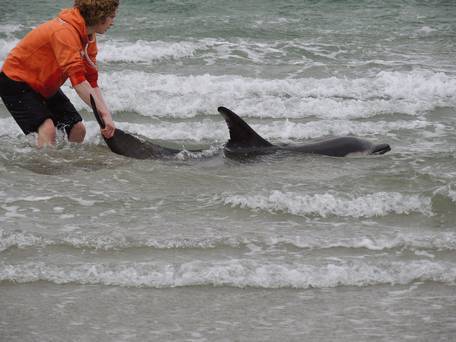 An Irish fish farm worker has been hailed a hero after single-handedly saving two dolphins from dying on a beach.
An Irish fish farm worker has been hailed a hero after single-handedly saving two dolphins from dying on a beach.
Shea Coyle (22) is more used to dealing with salmon in his job in Fanad, Co Donegal. And his dad Michael says the dolphins jumped out of the water “as if to say thank you” after the rescue.
The proud dad revealed how a cursory glance from the window of his home overlooking Downings beach led to the rescue.
“I looked out the window and I saw something in the water and at first I thought it was two surf boards turned upside down, with the fins showing above the water,” said Michael.
STUCK
“I got my binoculars to try to see more clearly and it was obvious this wasn’t a couple of surf boards. To be honest, I thought they looked like sharks.”
Michael and son Shea went down to the beach to investigate and soon realised that the two dolphins had become embedded in the sand in shallow water on Downings beach, on the Rosguill peninsula.
“They were in the water just about but they were stuck in the sand and trying desperately to wriggle free,” said Shea.
“I rolled up my trousers and got into the water and tried to get the first one shifted. After about 10 minutes I got one dolphin safely out into deeper water and he stayed there whilst I got to work on the other.
“I eventually got him – or her – out as well. And then they just took off.”
The father and son then walked to a nearby pier to see off the dolphins.
Michael told the Irish Independent: “They were jumping through the water, but they hung around the pier for a while.
“It was as if they were saying ‘thank you’ before heading off out to sea. I’ve never seen anything like that before here in Downings.”
The Irish Whale and Dolphin Group said there had been a number of “strange strandings” of dolphins in recent weeks, without any explanation.
Seven common dolphins were rescued on Tarmon beach near Blacksod, Co Mayo, a week ago. However, two of them later died.
Source: Independent

May 9, 2013
India rejects dolphinariums
From WDC:
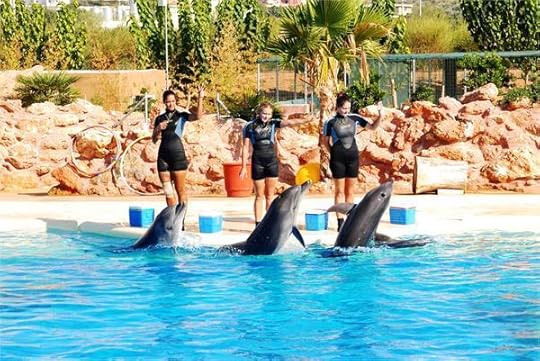 After many years of campaigning, we are delighted by the Indian government’s announcement that it will not allow the building of dolphinariums, and that they will shortly be banned altogether.
After many years of campaigning, we are delighted by the Indian government’s announcement that it will not allow the building of dolphinariums, and that they will shortly be banned altogether.
We recently increased our efforts to push for a ban following a number of proposals to keep dolphins in captivity in India. The country’s only attempt to keep captive dolphins ended in disaster when all three bottlenose dolphins died within months of the attraction opening.
India’s Minister for Environment and Forests, Jayanthi Natarajan said India will not permit dolphinariums to be built just days after the Minister received a letter from WDC (signed by 60 scientists and other groups) calling for a ban.
Our calls for action have been listened to and we would like to congratulate the Indian government for its highly progressive stance on the issue of dolphin captivity. Dolphins survive poorly in captivity and are subject to stress, aggression from pool mates, and premature death.
India lists all whales and dolphins in its Wildlife Protection Act, prohibiting their killing and capture. A ban on the opening of dolphinariums and imports from overseas will reduce the threat to wild dolphin populations in other parts of the world such as Japan, where dolphins are captured alive for sale to aquariums in cruel drive hunts.
WDC has worked with Wildlife Protection Society of India, Federation of Indian Animal Protection Organisations and Humane Society International, to block proposals for more of these facilities which threaten the welfare and conservation of dolphins.

May 8, 2013
A New Vision for Samadai Dolphin Retreat
It’s been a couple of months since announcement of the governmental decree assigning HEPCA as the managing entity of Samadai. The HEPCA team has made a lot of progress in a very short time and our vision for this precious dolphin sanctuary is nearly complete.
It’s up to the community now to unlock the true potential of this world-class tourism wonder. Proper management of this important natural resource will exemplify this destination’s environmental performance and thereby ensure our regions competitiveness on the world tourism market.
Despite some serious problems during the hand-over and many examples of blatant mismanagement; HEPCA has managed to overcome every obstacle.
We are on course for our Samadai dive guide training and certification. Dolphin researcher Angela Ziltener from the University of Zurich will be conducting the 3 hour training course and we will be providing all of the participants with new sales tools and channels.
HEPCA’s patrol boats have been stationed for duty at Samadai reef and our administration team is in the process of furnishing and equipping our office in Marsa Alam city. Our marketing team has prepared new Samadai pamphlets, ticket designs, info-graphics, and merchandise. Our exciting new web-site and resource portal dedicated exclusively to Samadai is now live – www.dolphinhouse.org
The site is an important educational resource containing years of information and research. We’ve also integrated exciting functionality into the site including; a forum, guest book, downloads, certified dive center listing and much more. We will soon be launching our Sponsor a Dolphin project which will allow individuals to “adopt a dolphin” and to help us protect them for the long-term.
Our new state of the art and mobile classroom the bio-boat is currently being built and will be deployed at the site by May. This facility will be manned by our dedicated personal and dolphin specialists. It will serve as a floating platform with observation deck, live green roof, science equipment, the latest multi-media tools and more.
HEPCA is planning to hire staff from the local community as the Samadai project develops and there is a lot of potential for employment and job creation if we succeed. A community based dolphin monitoring program for Samadai is another important aspect of the project that we will be announcing very soon.
The Samadai initiative is about our community finally having the opportunity to express a new ownership over the management of a very important national resource. HEPCA will be offering free excursions to Samadai for school children and local residents every Friday to re-ignite the community’s passion and environmental stewardship over this precious marine habitat.
We are once again asking all of our members, as well as the beneficiaries and the users of this unique site to support and help us in achieving these objectives.
Source: HEPCA

May 5, 2013
April 27, 2013
Why India Needs to Ban Dolphin Captivity Now
Ric O’Barry, former Flipper trainer and star of the Oscar-winning documentary The Cove, is asking that India take further steps to prevent the dolphin captivity industry from entering the nation.
“Since time immemorial, India has set the standard when it comes to having a compassionate attitude towards animals,” says O’Barry. “Enacting a ban on dolphin captivity will solidify their position as a global leader in animal welfare.”
As Director of Dolphin Project, O’Barry has worked for more than 40 years to end dolphin slaughter and exploitation. He is one of many renowned experts and scientists who are petitioning the Indian Minister of Environment and Forests, Jayanthi Natarajan, to implement a nationwide prohibition on dolphin captivity.
Natarajan is considering this prohibition in light of several captive facility proposals that are currently under review in the states of Maharastra, Kerala and others.
Source: TakePart

April 25, 2013
Strain of measles possible cause of dolphin deaths
Scientists think that more than a hundred dead dolphins found washed up on the Italian coast, may have been infected with a killer strain of measles.
The number of carcases has been building up on the country’s west coast since the start of the year.
Nicola Hodgins, an international project manager for the Whale and Dolphin Conservation Society, told BBC Radio 5 live Breakfast that the ‘origin of the disease is unknown’.
Source: BBC

April 17, 2013
Dolphin deaths ‘worry’ South Australians
A public meeting will be held next week amid ongoing concerns over fish and dolphin deaths along South Australian beaches.
Over Easter tens of thousands of small fish washed up dead, and authorities attributed the large kill to algal bloom sparked by unseasonal winds.
But they remained baffled by a spate of dolphin deaths with 16 reported cases across the state in March and the toll growing to 24 in April. The latest was on Adelaide’s south-coast on Wednesday.
SA Museum officials have conducted post mortem examinations on some of the dolphins and are waiting for the results.
They say more examinations have also been scheduled.
Adelaide man Nigel Black has organised a public meeting at Port Noarlunga on April 24 and has called on the state government to provide some answers for the deaths.
He said there was much speculation in the community attributing the cause to algal bloom, the recently completed desalination plant or possibly ships dumping waste into the sea.
“I would not know myself, but I am sick of seeing dead animals on the beach,” Mr Black said on his Facebook page where more than 200 people have already indicated they will attend the meeting.
“One thing is certain – the picture is not clear and we should demand an answer.”
After investigating the fish deaths over Easter, Biosecurity SA’s manager of aquatic pests Vic Neverauskas said scientists were confident they were the result of an upwelling of cold water from deep in the ocean.
Fanned by three weeks of winds from the southeast this nutrient-rich water was pushed up the coast towards Adelaide, triggering the algal bloom which in turn clogged the gills of small fish.
“This phenomena happens every single year to a greater or lesser degree,” he said.
Scientists said the same cause could not be attributed to the dolphin deaths.
Source: 9News

March 30, 2013
Last chance to win a copy of Dolphin Way on Goodreads – it ends tomorrow!
.goodreadsGiveawayWidget { color: #555; font-family: georgia, serif; font-weight: normal; text-align: left; font-size: 14px;
font-style: normal; background: white; }
.goodreadsGiveawayWidget img { padding: 0 !important; margin: 0 !important; }
.goodreadsGiveawayWidget a { padding: 0 !important; margin: 0; color: #660; text-decoration: none; }
.goodreadsGiveawayWidget a:visted { color: #660; text-decoration: none; }
.goodreadsGiveawayWidget a:hover { color: #660; text-decoration: underline !important; }
.goodreadsGiveawayWidget p { margin: 0 0 .5em !important; padding: 0; }
.goodreadsGiveawayWidgetEnterLink { display: block; width: 150px; margin: 10px auto 0 !important; padding: 0px 5px !important;
text-align: center; line-height: 1.8em; color: #222; font-size: 14px; font-weight: bold;
border: 1px solid #6A6454; -moz-border-radius: 5px; -webkit-border-radius: 5px; font-family:arial,verdana,helvetica,sans-serif;
background-image:url(http://www.goodreads.com/images/layou... background-repeat: repeat-x; background-color:#BBB596;
outline: 0; white-space: nowrap;
}
.goodreadsGiveawayWidgetEnterLink:hover { background-image:url(http://www.goodreads.com/images/layou...
color: black; text-decoration: none; cursor: pointer;
}
Goodreads Book Giveaway

Dolphin Way
by Mark Caney
Giveaway ends March 31, 2013.
See the giveaway details
at Goodreads.


